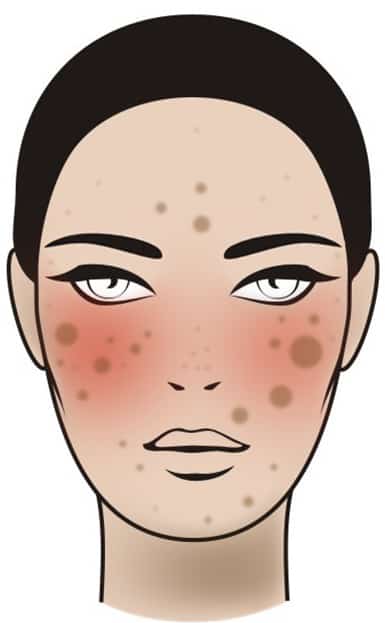Have questions about Hyperpigmentation and want to understand it better? Well, we’ve got you covered! This skin condition is under our beauty microscope this week, so scroll down to read what exactly hyperpigmentation is, the different types and the possible treatments for it:

What Is Hyperpigmentation?
Hyperpigmentation is a common and usually harmless condition in which patches of skin become darker than the normal surrounding skin. It is caused by an increase in melanin which is the natural pigment that gives our skin, hair and eyes their color. Many factors can trigger an increase in melanin production but the most common ones include sun exposure, hormones, age and inflammation. This condition affects people of all skin colors.
Types And Symptoms
Darkened patches can vary in size and develop anywhere on the body. There are several types of hyperpigmentation. However, these are some of the more commonly known types:
- Melasma: Also known as Chloasma, this is a condition where large patches of hyperpigmentation develop mainly on the face. It most commonly affects women and is believed to be triggered by changes in hormone levels. It occurs in 10-15 percent of pregnant women and 10-25 percent of those taking oral contraceptives.
- Sunspots: Sunspots are caused by sun exposure. Excess sun exposure over time leads to them and theygenerally appear on the face, neck and hands.
- Post-inflammatory hyperpigmentation: This condition occurs when a skin injury or trauma heals and leaves a flat area of discoloration behind. This is commonly caused by acne. Popping pimples or other interference that may cause inflammation increases the risk of that pimple leaving a mark.

Causes
Individuals with dark skin are more likely to be affected by hyperpigmentation marks than those with lighter skin tone because the skin pigmentation is stronger in dark skin. Melanin is what gives our skin its color. Those with more melanin in their skin are more prone to a triggered increase in melanin production. That being said, the biggest risk factors for hyperpigmentation are sun exposure and inflammation.
Diagnosis And Treatment
If you are concerned about any of your dark spots, it is always best to consult your dermatologist or pharmacist. The most important step to prevent hyperpigmentation is sunscreen. A broad-spectrum coverage sunscreen that is at least SPF 30 to 50 is ideal. SPF must be reapplied every two hours if you are out in the sun. It is not always possible to avoid hyperpigmentation as it is a natural part of our skin’s response, however you can take these steps to minimize damage:
- Using sunscreen with an SPF of at least 30
- Wearing hats or clothing that block sunlight
- Avoiding the sun between 10 a.m. to 4 p.m., when the sun’s UV rays are the strongest
Many people use topical treatments to treat hyperpigmentation. The following treatments include the following ingredients:
- Azelaic Acid
- Corticosteroids
- Hydroquinone
- Kojic Acid
- Retinoid
- Vitamin C
Certain cosmetic procedures can also lighten areas of the skin to reduce the appearance of hyperpigmentation including:
- Laser therapy
- Intense pulsed light
- Chemical peels
- Microdermabrasion
It is important to note that these procedures should only be done by a dermatologist.









What do you think?
You must be logged in to post a comment.